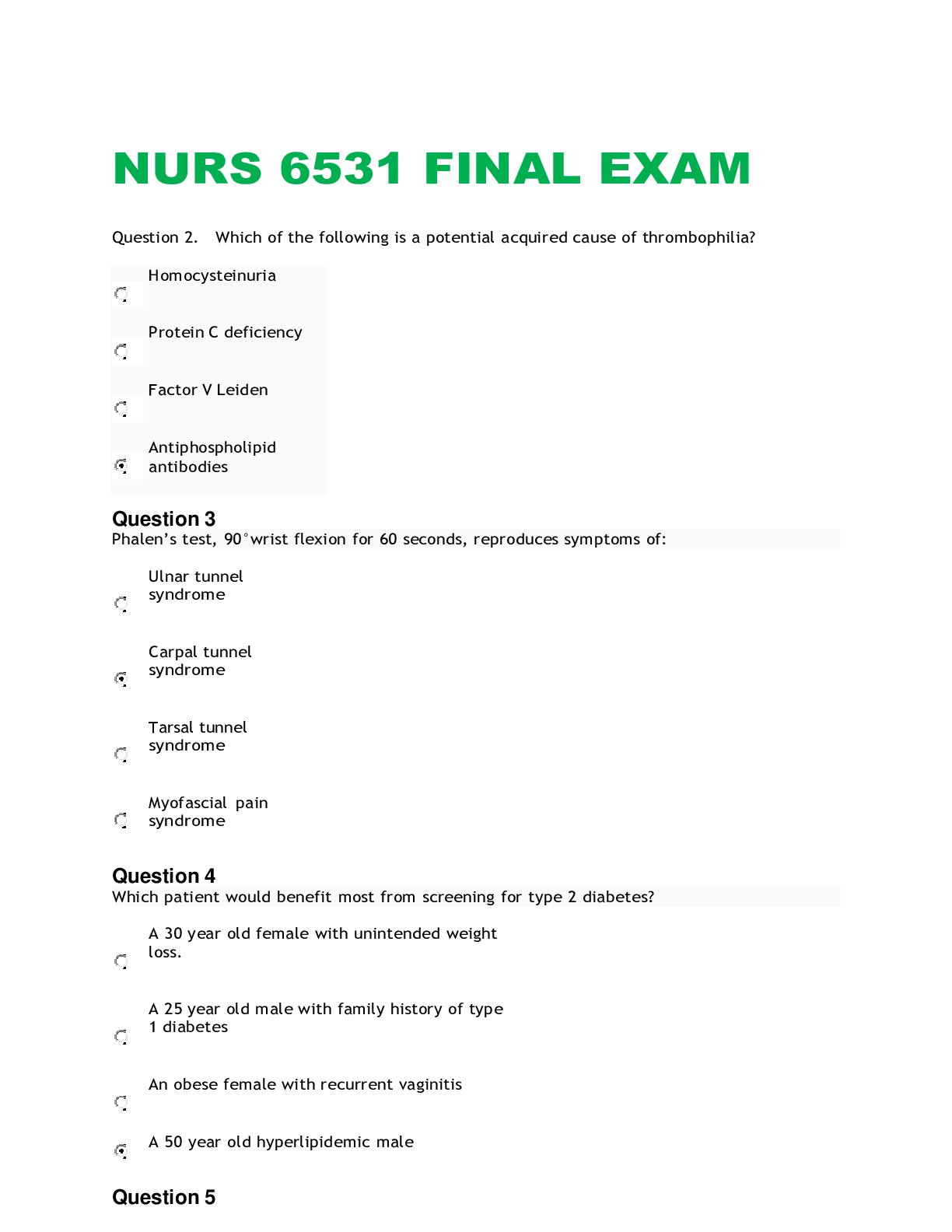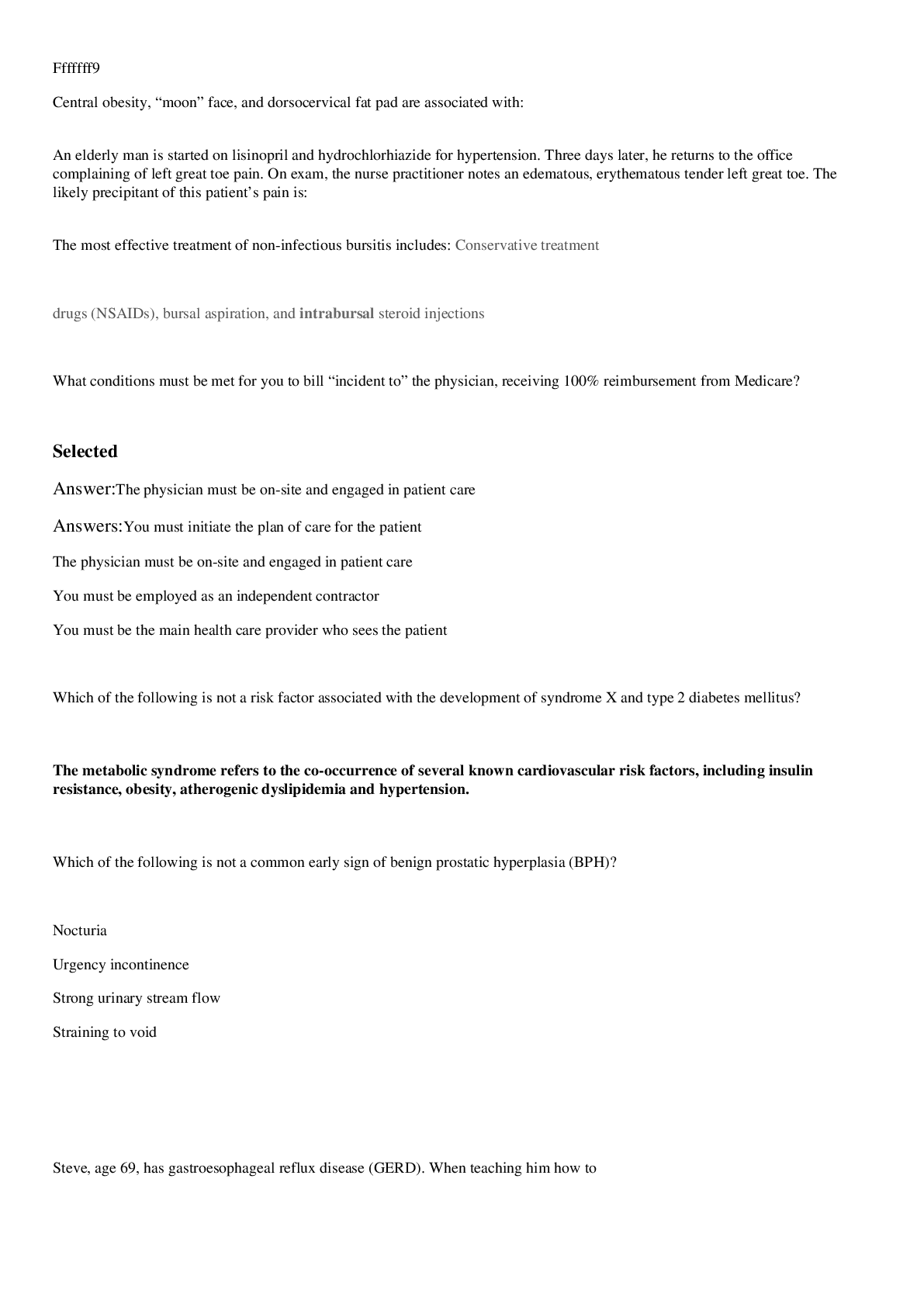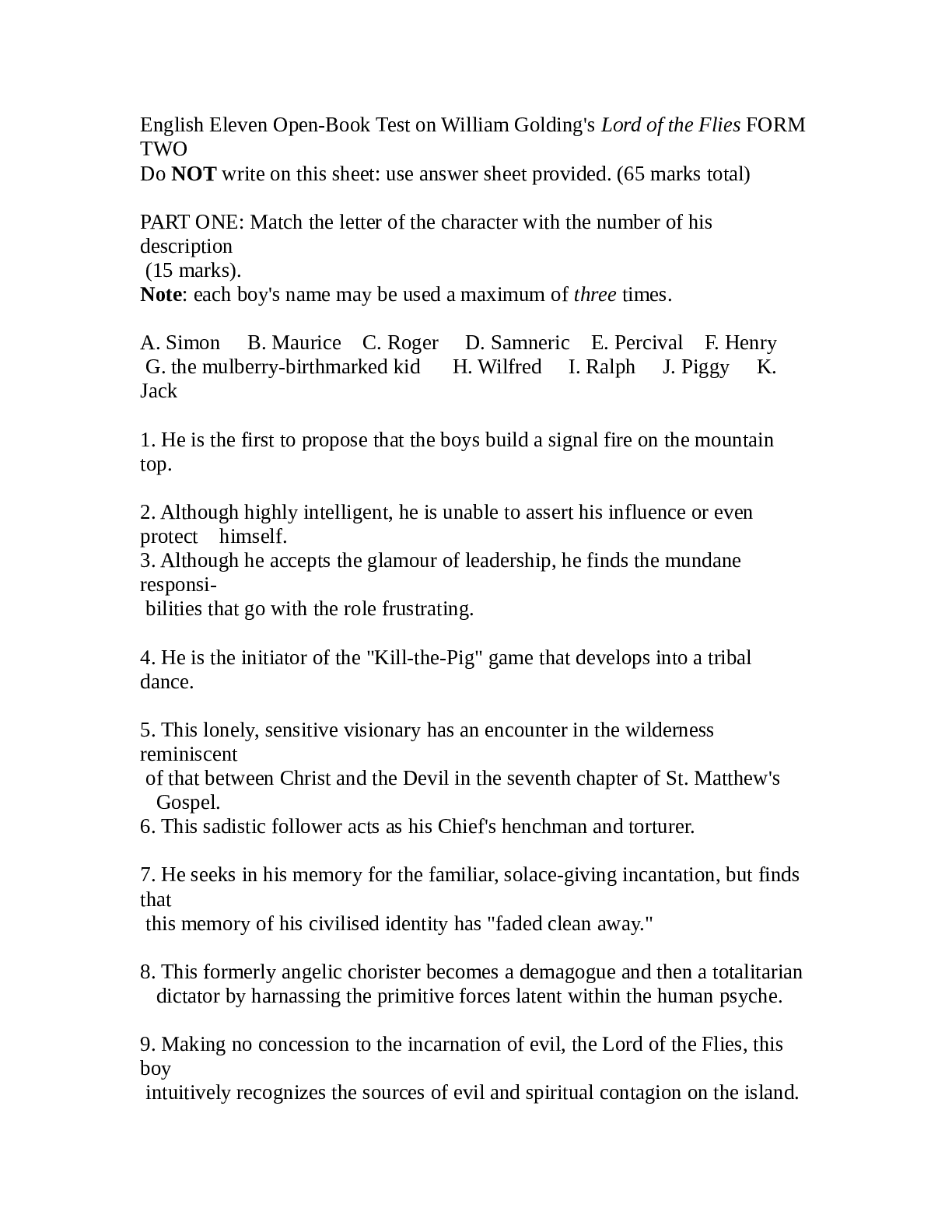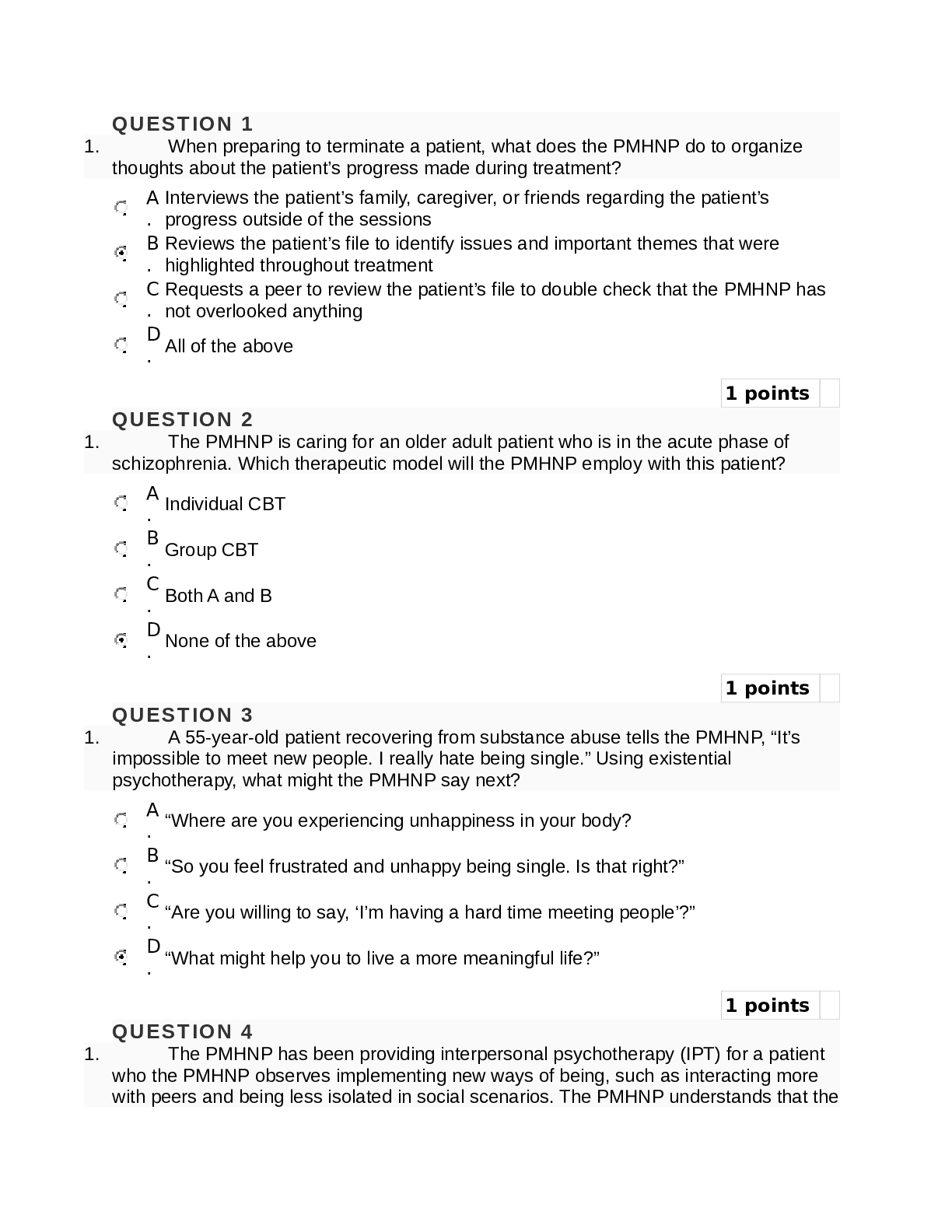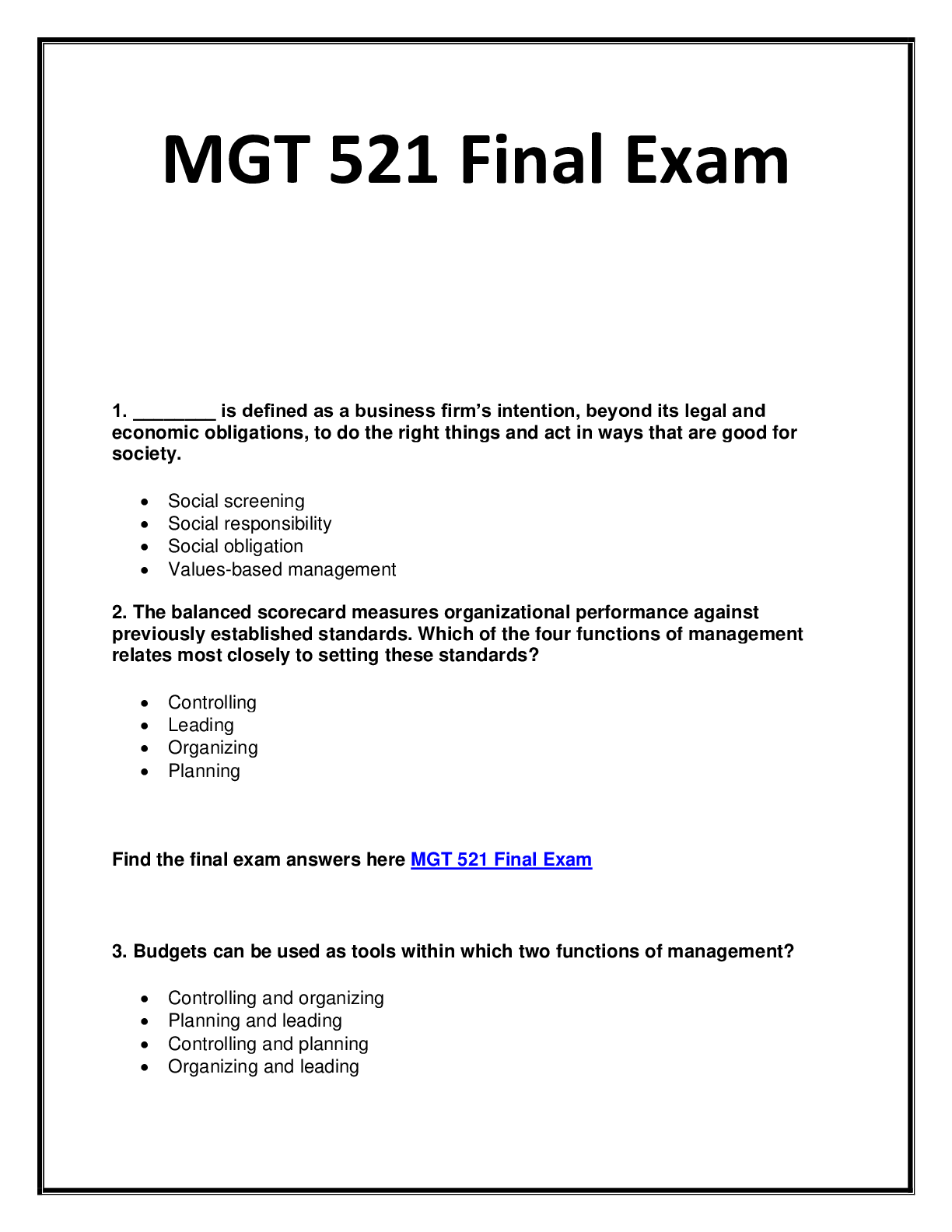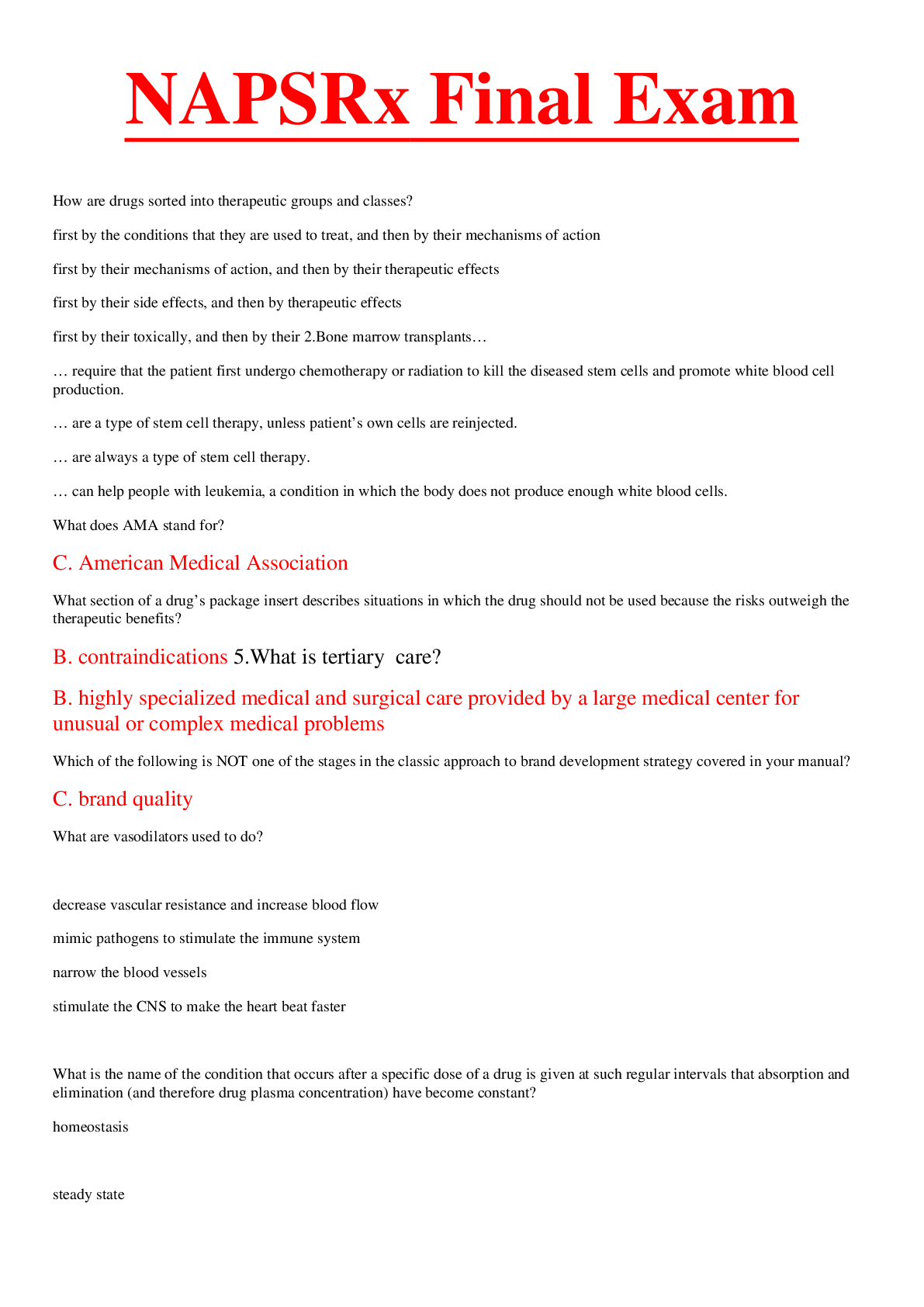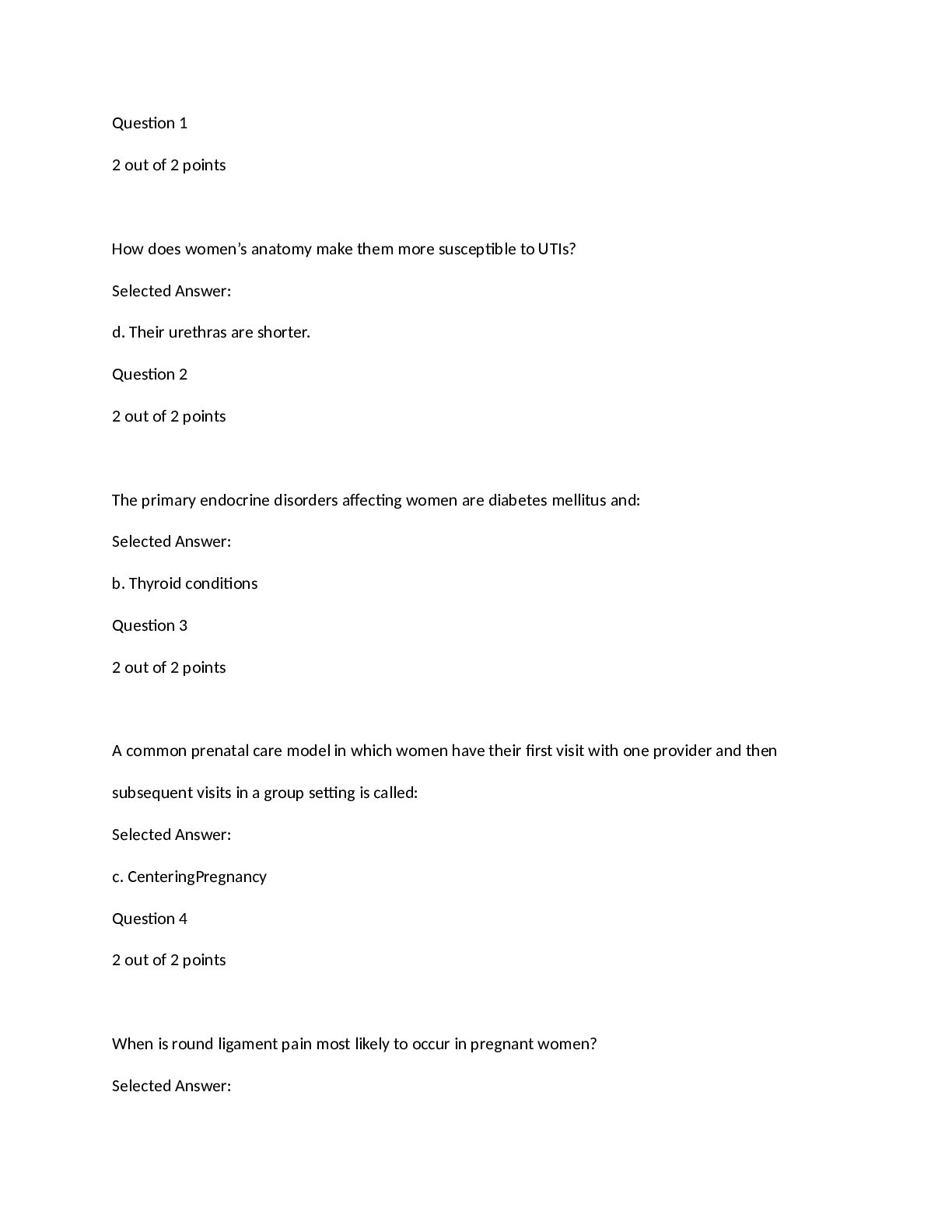*NURSING > Final Exam Review > pedi nurs6541 final exam with correct answers (All)
pedi nurs6541 final exam with correct answers
Document Content and Description Below
pedi nurs6541 final NURS 6541 final may 2020 Question 1 1 out of 1 points A small-for-gestational-age, dysmorphic newborn infant has microcephaly and sloping forehead, cutis aplasia (m... issing portion of the skin and hair) of the scalp, polydactyly, microphthalmia, and omphalocele. Which of these is the most likely diagnosis? • Question 2 • 1 out of 1 points A 16-year-old girl has enuresis, frequent urination, a white vaginal discharge, and a dark rash around her neck. Her serum glucose level is 250 mg/dL, and her urinalysis is positive for 2+ glucose but is otherwise negative. Which of the following is the most likely diagnosis? • Question 3 • 1 out of 1 points Mark, age 15, is 5 feet tall andn weighs 85 pounds. You suspect anorexia and know that the best initial approach is to • Question 4 • 1 out of 1 points Which of the following is not a sign or symptom of congenital hypothyroidism? • Question 5 • 0 out of 1 points While doing a 5-year-old well child exam, you notice two small patches of hair loss. Broken hair is present, as is erythema and scaling. On the basis of this information, which of these is the likely diagnosis? • Question 6 • 1 out of 1 points Hope is a 7-month-old who presents in January with a 1-day history of cough, yellow nasal discharge, and low-grade temp (T max 100°F). She was previously healthy. She does have 2+ edema of the nasal turbinates and cloudy rhinorrhea. She is afebrile in the office. Her chest, mouth, and ears are clear. You prescribe: • Question 7 • 1 out of 1 points The parents of an 8-year-old Down Syndrome boy arrive for his annual well-child visit. He wants to participate in sports, including the Special Olympics. Until further examination can be completed, which of the following sports would you suggest as being safe? • Question 8 • 1 out of 1 points Jason, age 14, appears with tender discoid breast tissue enlargement (2-3 cm in diameter) beneath the areola. Your next action would be to • Question 9 • 1 out of 1 points You see a 7-year-old boy a day after he was bitten by his pet dog. According to the mother, the dog bit the child after he snuck up on the dog and grabbed his tail. The dog has had all its vaccinations, including rabies. The child has had no fever, has full movement of the injured limb, and has no sign of neurologic or vascular injury. The wound is on the child’s forearm, is not deep, and is not bleeding, but has developed about 2 cm of erythema surrounding the site. Which of the following is the most appropriate treatment? • Question 10 • 1 out of 1 points A head injury in which bruising or tearing of the cerebral structures occurs is a • Question 11 • 1 out of 1 points A 14-year-old has a 3-week history of fever, anorexia, and abdominal pain. What additional symptom would cause the NP to suspect Crohn's disease? • Question 12 • 1 out of 1 points Which of the following should be done annually after 1 year of age in a child with Down syndrome? • Question 13 • 1 out of 1 points A previously healthy male has a 3-month history of increasing headaches, blurred vision, and personality changes. Previously he admitted to marijuana experimentation more than 1 year ago. On examination he is a healthy, athletic-appearing 17-year-old with decreased extraocular range of motion and left eye visual acuity. Which of the following is the best next step in his management? • Question 14 • 1 out of 1 points Kelly, your 11-year-old well visit patient, presents to the office with weight loss, polyuria, and polydipsia. Which of the following do you need to rule out? • Question 15 • 1 out of 1 points A 3-week old presents to the office in January with a 1-week history of nasal congestion and occastional cough. On the night prior to the visit in infant developed a fever 102ºF rectally, was difficult to breastfeed, and had paroxysmal coughing and noisy, labored breathing. On exam, you note an ill-appearing infant who is lethergic with wheezing, tachypnea, and intercostal retractions. The infant is home with the mom at this time; however, has a sibling who is 4-years-old and is in daycare and recently had cold symptoms. If the patient has been diagnosed with RSV bronchiolitis, which of the following would be the treatment of choice? • Question 16 • 1 out of 1 points Chest pain in young children is usually • Question 17 • 1 out of 1 points Maddie, age 2, had a complete blood count (CBC) drawn at her last visit. It indicates that she has a microcytic hypochromic anemia. What should you do now at this visit? • Question 18 • 1 out of 1 points Most children with Duchenne muscular dystrophy become wheelchair dependent by what age? • Question 19 • 1 out of 1 points The following clinical description best matches which genetic disorder? A tall, thin 14-year-old boy has no signs of puberty. He was delayed in his speech development and always has done less well in school than his siblings. He is shy, and teachers report his activity is immature. Physical examination reveals breast development, and long limbs with a decreased upper segment/lower segment ration. He has small testes and phallus. • Question 20 • 1 out of 1 points Of the following patients, which child should not receive a tuberculin skin test? • Question 21 • 1 out of 1 points A 10-year-old male presents with a fever of 102ºF and complaints of leg pains. His mother reports that he had an upper respiratory infecion with a sore throat about 2 weeks ago. No treatment was needed. On examination, he has tender and swollen knees bilaterally. His heart rate is 125 bpm and a blowing systolic murmur is heard at the apex. No murmur was noted at in the chart. The mostly diagnosis is: • Question 22 • 1 out of 1 points When a neonate is initially protected against measles, mumps, and rubella because the mother is immune, this is an example of which type of immunity? • Question 23 • 1 out of 1 points Sarah, age 13, is markedly obese and has a poor self-image. How do you differentiate between compulsive eating and bulemia? • Question 24 • 1 out of 1 points Seborrhea dermatitis is common for both infants and adolescents. Which is not correct for this condition? • Question 25 • 1 out of 1 points Which chromosomal abnormality is associated with short stature in girls? • Question 26 • 1 out of 1 points You see a patient you believe has folliculitis. What medication would be the best to treat this patient? The patient has no allergies. • Question 27 • 1 out of 1 points Antibiotic therapy is one of the mainstays of treatment for which of the following causes of wheezing? • Question 28 • 1 out of 1 points Which of the following symptoms are most suggestive of pneumonia in a young child? • Question 29 • 1 out of 1 points An 11-year-old has been diagnosed with mild intermittent asthma. Which of the following is not a routine part of the clinical management? • Question 30 • 0 out of 1 points Generalized absence seizures usually occur in which age group? • Question 31 • 1 out of 1 points Which test is routinely recommended for a preparticipation sports physical? • Question 32 • 0 out of 1 points A healthy, thriving 4-year-old male has had sudden episodes of drawing his knees to his chest and crying like he is in acute pain for the last 5 hours. These episodes are separated by quiet times when he appears normal and comfortable. He is not vomiting and has not had a bowel movement today. What is the most likely diagnosis. • Question 33 • 1 out of 1 points ……………………………………….CONTINUED……………………………………… [Show More]
Last updated: 2 years ago
Preview 1 out of 22 pages

Buy this document to get the full access instantly
Instant Download Access after purchase
Buy NowInstant download
We Accept:

Reviews( 0 )
$15.00
Can't find what you want? Try our AI powered Search
Document information
Connected school, study & course
About the document
Uploaded On
Jan 22, 2021
Number of pages
22
Written in
Additional information
This document has been written for:
Uploaded
Jan 22, 2021
Downloads
0
Views
116

